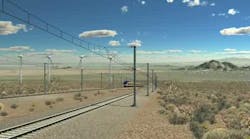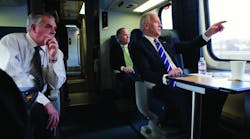It is becoming increasingly clear that it would be a grave mistake to spend another dime on California's high-speed rail fantasy. The latest blow to the project comes from state Auditor Elaine Howle, who said that "the program's overall financial situation has become increasingly risky."
Her negative report comes on top of severe criticism from the Legislative Analyst's Office and the rail authority's own peer review group.
They all have accurately concluded that the rail project lacks anywhere near the state, federal and private financing required to build a $98 billion high-speed rail system from the Bay Area to Los Angeles.
Howle questions the rail authority's ridership projections, saying the group that reviewed those numbers was "hand-picked" by the authority's chief executive officer.
Ridership is the foundation to the fiscal viability of the rail system. Without an adequate number of riders, there will not be a sufficient revenue stream to pay for operational expenses and to attract private investors, both of which are requirements for the success of high-speed rail and to meet the mandates of the rail bond measure voters passed in 2008.
There is no way the high-speed rail can meet the latest forecast of 36.8 million rides a year on a San Francisco-to-Los Angeles system. Where will the riders come from? There are only about 3.2 million airline riders a year going to and from Los Angeles and San Francisco and another 1.7 million traveling between Los Angeles and Oakland and San Jose.
That's 4.9 million airline riders. Even if all of them quit flying and took the train, another 31.9 million riders would have to come from those who now drive. But why would huge numbers of motorists choose a 2.5-hour train ride when they have rejected a one-hour plane ride?
The auditor also found that:
The cost estimates do not include phase one's operating and maintenance costs, yet based on data in the plan these costs could total about $96.8 billion from 2025 through 2060.
There are no details about the current largest potential funding source, the federal government.
There have been inappropriate contracting practices such as splitting Information Technology services totaling $3.1 million into 13 individual contracts with one vendor. The State Contracting Manual prohibits agencies from splitting contracts to avoid competitive bidding requirements.
The authority is missing statements of economic interest for some of its contractors despite the conflict-of-interest code requirements; and the authority does not require any of its subcontractors to file statements of economic interest. As a result, the authority has no way to verify that subcontractors do not have real or perceived conflicts of interest.
It is time for Gov. Jerry Brown to face reality and kill the high-speed rail project as it is now configured. Committing billions of dollars of money that could be used for schools and other needed state services makes no sense at a time of large budget deficits and could undermine the governor's ballot initiative asking for tax increases.
Copyright 2005 LexisNexis, a division of Reed Elsevier Inc. All rights reserved.
Terms and Conditions | Privacy Policyolicy



